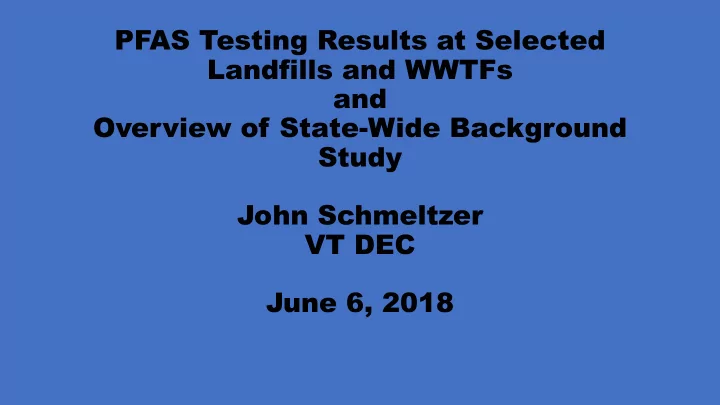

PFAS Testing Results at Selected Landfills and WWTFs and Overview of State-Wide Background Study John Schmeltzer VT DEC June 6, 2018
Started in Bennington-2016 Water Supply Wells-nd to over 2500 ppt Bennington Landfill Leachate Vault-over 5,000 ppt PFOA WWTF-over 350 ppt influent WWTF-6 to 8 ppb pressed Sludge samples Elevated PFOA in Septic sludge
What are PFOA concentrations in leachate and influent/effluent at other Facilities? Fall-Winter 2017 Developed Scope for State-Wide Sampling at • these facilities Selected five landfills • Selected six WWTF (those that received leachate from • landfills Analytical Methods-Currently not consensus and Evolving • MLA 110-DOD approved method (primary) • Modified EPA 537Results from WWTP influent 350 • Samples collected in Winter 2018 • Report May 3, 2018 •
PFAS results from analysis of WWTP Influent and Effluent by MLA 110 (January 2018) [Bolded values indicate result above detection level] • ALL PFAS results are in ppt (ng/L) range • Maximum effluent PFOA/PFOS values (Facility E), maximum influent values (Facility F) • Average PFOA and PFOS for all 6 facility effluent and influent samples in last two columns
PFAS PF AS resu esults fr lts from an om anal alysis of ysis of WWTP WWTP Influen Influent t and an d Ef Effl flue uent nt [Bolded values indicate result above detection level] Six (6) WWTFs that receive landfill leachate • Grab samples collected from INFLUENT, • EFFLUENT, RESIDUALS Analyzed by MLA 110 and EPA modified 537 and • SPLP (sludge) ALL results are in ppt (ng/L) range • * RPD calculated as means of comparing methods. * RPD improves dramatically when method yields results above the method detection limit !!
PFAS results from analysis of WWTP Residuals by MLA 110 MLA 110 method produced • the “best results” (lowest RL/DL) compared to modified EPA 537 for solids All PFAS detections for • sludge in the low ppb range from < 1 to 14 ug/kg
PF PFAS S results esults fr from om an anal alys ysis is of of WWTP WWTP Residua esiduals ls by by MLA LA 11 110 an 0 and d EP EPA 53 537 an 7 and d SPLP SPLP [Bolded values indicate result above detection level] • Method comparison – note high detection limits for EPA 537
SPLP Result SPLP R esults SPLP = synthetic precipitation leaching • Procedure (how much PFAS leaches from sludge • exposed to slightly acid rainfall) Results Max = 22.7 ppt PFOS • Avg = 13 ppt PFOS Max/avg = 5 ppt PFOA
PFAS results from analysis of Landfill Leachate (March 2018)
TOP ASSA OP ASSAY-One WW One WWTF a TF and One L nd One Landfi andfill ll • WWTF Effluent No Precursors due to oxidation but high reporting limits • Landfill Leachate several PFCs (5-12 carbon chains) increased
____________________________________ PFAS Results from Bennington WWTF PFOA PFOA Media 2016 2018 Influent 350 ppt 39.7 ppt ND – 430 Effluent ND - 69 SPLP 66-69 ppt 62.6 Sludge 6.9-8.2 ppb 9.1 ppb
Summary of State-Wide Study Results • PFOA concentrations found in Leachate and at WWTF • PFOA concentrations in Leachate below Recommended Guidelines-requiring no restrictions prior to discharging to a WWTF • Modified 537 more sensitive to matrix interference than MLA 110 • TOP ASSAY a tool to identify the character of the mixture present and potential future problem with PFAS
What’s Next? • VT DEC reviewing the results and conferring with other States, EPA, Regional and National Organizations • Work in Progress…Stay Tuned
____________________________________ Ac Ackn knowl wled edge gemen ments ts Ea Eamon mon Twoh ohig ig R Resid esidua uals ls Man Manage gemen ment t an and d Eme Emerging ging Conta Contaminan minants Pr ts Prog ogram am Westo eston an n and d Sa Samps mpson on-Ste Steve e La LaRosa osa and and Ste Steve Sh e Shaw aw
Overview State-Wide Background Study • Why do we need one? • Many argue it is everywhere-It is in the blood of Polar Bears • “Background” Samples Results collected at part of area -wide Site Investigation in Bennington had higher than expected levels of PFCs in soils. • An argument is being made that PFCs in soils, particularly the eastern side, reflect a regional background. We don’t believe it. • Winter 2018 VT DEC requested Grant Proposals • University of Vermont Awarded Grant
Study Approach • Grantee to obtain soil samples from around Vermont to be analyzed for poly and per-fluoroalkyl substances (PFAS) and Total Organic Carbon (TOC) • Starting point-select locations (state property, municipal parks, etc.) used in recent VT Background Study for lead, arsenic and PAHs • Screen out locations that may be located near and known and suspected source of PFAS
Study Approach (Continued) • Modified EPA 537 proposed • Principal Component Analysis to be performed on Results
Current Timeline • Preparation of QAAP/Sampling Plan, HASP etc. - pending • Perform Sampling-Summer 2018 • Report Sampling Results-September 2018 • Present Findings and Regional and National Meeting and plan to publish in technical journal- December 2019
Questions? Thank you! Contact information: John Schmeltzer 802-249-5620 John.Schmeltzer@vermont.gov
Recommend
More recommend